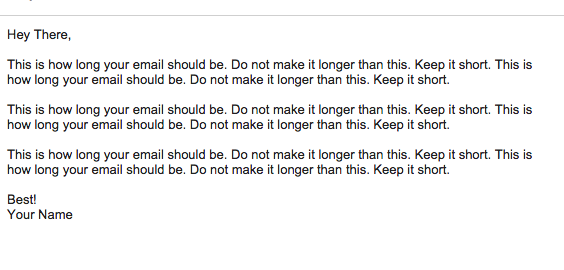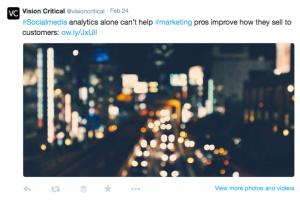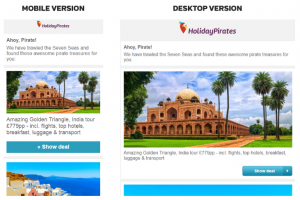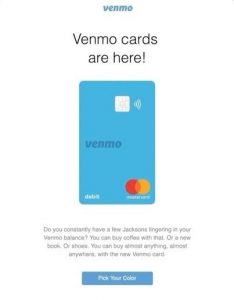I don’t have a lot of fears. I wouldn’t say that I’m brave, maybe I’m more ignorant to the consequences. I got back a few weeks ago where I was asked if I wanted to zip line and I said yes without even doubting myself. (If you want proof, I do have pictures). There are probably more extreme things that I could do and I know that I wouldn’t hesitate to do them.
However, there are a few things that cause sinking pits to form in my stomach and make my palms slightly sweaty. One of those fears is sending a cold email. A fear rushes over me just before and after I hit send. “What if I missed a typo?” What if I spelled their name wrong?” “What if they share this email with all of their colleagues and I’m the new laughing stock at their company?” These what ifs sometimes spiral out of control, but I’ve learned to control them a bit. And after getting over my anxiety, I’ve even been fortunate to find ways to get majority of my cold emails opened and read.
I might be the only one who would list one of my fears as cold emailing, but developing tactics that get this scary cold emails opened, read, and responded to is beneficial for everyone. So, what are the factors that get you what you want from your cold emails?
7 Elements to Get Your Cold Emails Opened
1. Segmentation
Time and time again, the best performing emails and email campaigns are the ones that…segment. We’ve talk extensively about segmentation, but the most successful “cold emails” are sent to specific segments that you organize.
For a cold group of contacts, you should separate them out from the contacts in your database that you know and interact with. These contacts should receive the white-glove service at first and depending on the size the segments should be broken out into order of importance. This will help you tailor your message and your “ask” at the end.
Need some ideas on how to segment your contacts? Check out our best segments here.
2. Timing
After you’ve segmented your lists, you may have an idea who these individuals are and where they are located.
The timing in sending any email is extremely important and people are constantly searching for the best advice on what time to send an email. People are on and interacting with emails at certain times of the day. There are some outliers to this, but look at where your individual and/or group is located and send it at an optimal time.

via Adweek
Sometimes emails are best sent after 8pm as many are wrapping up their days and browse through their email after dinner at home. Or often times sending an email first thing in the morning at 6am will ensure that your email hits the top of their inbox. Test out different times you are sending emails to figure out the best time that works for you.
3. Personalization
Personalization doesn’t just mean putting their name in the subject line, it can go beyond that and will be one of the biggest trends in email in 2016.
Personalization means looking at who your audience and identifying the factors that make them unique. You can personalize by location, job title, responsibilities, or behaviors they take. If they are a millennial buyer looking for their first house, how can you tailor the message to them to make sure your cold email resonates with them?
Look on LinkedIn to see if you can find out their job title and responsibilities, take a look on Twitter to see if they’ve tweeted out any problems they are currently having, and/or see if you can identify some demographic data about them. You want to avoid sounding creepy, so do not call out specifically what you found. Instead, draw connections with these observations and data points to personalize your cold outreach.
4. Subject Lines
After individuals search for the best time to email, they search for the best subject line. We have some ideas on the best subject lines to add to your emails, but when you are sending a cold email you should pay close attention to your subject line. It’s the introduction that will make or break the success of your cold email.
Our three suggestions are:
1. Simple “Hello”
Disclaimer: This subject line could backfire and it may get opens, but no responses.

President Obama famously used “Hey” as one of his subject lines in an email campaign. It was personable and seemed like an email coming from a friend. You can evoke the same emotions with the subject line of your email that you are sending. This subject line greeting immediately starts the conversation out. Because the conversation has start, the recipient could want to open up the email and see how the rest unfolded.
As we mentioned above, this could backfire and you could have high opens rates with low response rates. Make sure the body of the email keeps things going.
2. Objective of the email
What is the purpose of your email? Answering that in your subject line will help increase the odds that your email will be opened and keep you aligned with the entire messaging of the email. An objective subject line will tell the person what they are about to get into and help prep them for the continued conversation.
If you’re struggling to think of something creative for your subject line, we’d recommend sticking with this tried and true subject line.
3. Ask a question
I received an invite to a webinar the other day and the subject line of the email asked me a pointed question. I’m not sure if they meant to or not, but you better believed I opened the email to see if they had the answer to my question.
Questions are very compelling, especially if you ask the right ones. Use the personalization research that you found and formulate a question to ask in your subject line. You’ll probably be surprised how well this works.
5. Personable Friendliness
I wish I kept a tally on emails that I receive starting out with “To whom it may concern,” so that I could give you my own accurate data point on this and compare it to how many of those emails I’ve responded to. Don’t worry, we’ve all been there and we’ve probably all used that as our opening line in some form of communication. Although you don’t know this person at the other end of your cold outreach yet, save the formalities for an official note, not this cold email.
Keep your tone light, personable, and friendly that way the recipient of your email knows that there is another person at the other end of your email not a robot. Besides the tone, keep your fancy designed emails for something else. There’s nothing more personal that a straight text email.
6. Keep it short
When I receive emails that are paragraphs long, I know I need to set aside time to look through that email. However, these are mostly from people I know and if I received an email from someone I didn’t know that was paragraphs long, it may fall to the wayside in my inbox.

Your cold email should be short and to the point. Think about it if you were the recipient. If you get a shorter email, you’ll probably answer it and if there needs to be a longer response you may schedule a time to talk later.
In this cold email aim for no more than 6-9 sentences and an email that can be easily read on a mobile device. Keeping it short will give the person time to answer rather than having their time taken up reading through your entire email.
7. Ask for next steps
Sending a cold introduction may open up the pathway to more things, but if you don’t follow through with anything after the introduction you’ve just shaken someone’s hand and walked away.
Why are you sending this cold email? Why do you want to reach out to this individual? Answer those questions at the end of your email. Tell the recipient why you are emailing them and ask them the question you’re hoping they’ll answer back. Your cold email has a higher chance of success when you open it for the opportunity when you ask for the next steps.
Turn Cold to Hot
Sending a cold email may be at the very bottom of the start of this new business relationship, but every relationship has to start from somewhere. Push past the angst and use these elements to get your cold email opened, read, and responded. It’s not as hard as it may seem.
Digital & Social Articles on Business 2 Community(437)






